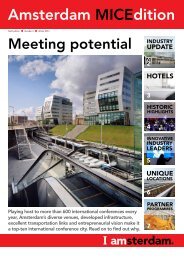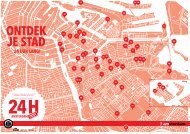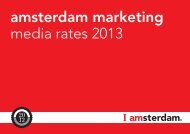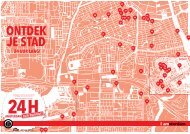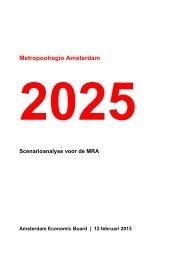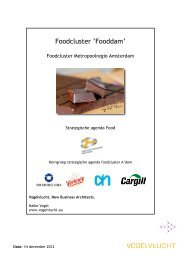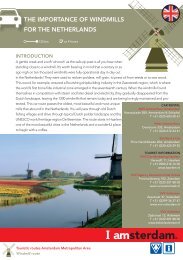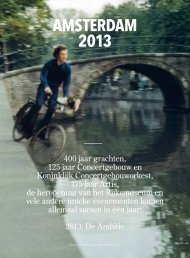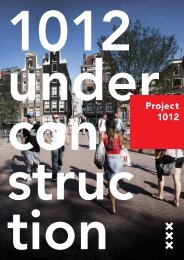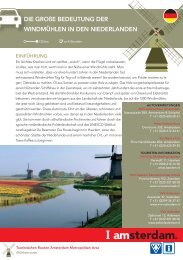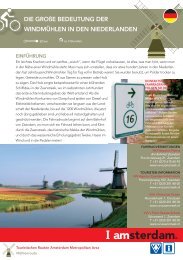citymarketing 5 - I amsterdam
citymarketing 5 - I amsterdam
citymarketing 5 - I amsterdam
You also want an ePaper? Increase the reach of your titles
YUMPU automatically turns print PDFs into web optimized ePapers that Google loves.
• Bij welke doelgroepen heeft Amsterdam momenteel<br />
reeds een sterke mentale positie (Amsterdam heeft in de<br />
ogen van deze doelgroepen nu al veel te bieden)?<br />
• Welke doelgroepen hebben elkaar nodig en versterken<br />
samen de marktpositie van Amsterdam (bijvoorbeeld -<br />
kenniswerkers en innovatieve bedrijven); met andere<br />
woorden, welke doelgroepen zijn èn als afnemer èn als<br />
mede-producent van belang?<br />
Op basis hiervan zijn zeven primaire doelgroepen voor de city<br />
marketing van Amsterdam benoemd:<br />
1. Zakelijk beslissers van internationale ondernemingen, die<br />
hun Europese hoofdkantoor in de regio Amsterdam vestigen,<br />
mede vanwege de virtuele “Gateway to Europe”<br />
(ABN Amro, Heineken, Hitachi, ING, KBB Vendex, KLM,<br />
Microsoft, Numico, Cisco, Philips en zo verder).<br />
2. Logistieke dienstverleners: de partijen die in opdracht van<br />
derden (veelal de ladingeigenaren zoals de industrie) zorgen<br />
voor opslag en vervoer van goederen binnen Europa.<br />
Ook kunnen zij de bewerking en assemblage ervan regelen<br />
of zelf doen. Interessante industriële partijen voor de<br />
Amsterdamse regio zijn de industrieën die grondstoffen<br />
verwerken tot halffabrikaten of eindproducten – wat een<br />
hoge toegevoegde waarde voor de regio betekent – dan<br />
wel een locatie zoeken voor de distributie van hun eindproducten.<br />
3. Creatieve industrie: design-bedrijven in media, contentproducenten,<br />
vormgevers, ICT, mode, productie en zakelijke<br />
dienstverlening, veelal bestaand uit middelgrote en<br />
kleine ondernemingen en veelal geleid door jonge Nederlandse<br />
ondernemers.<br />
4. Kenniswerkers: veelal jonge creatievelingen en wetenschappers,<br />
die zich aangetrokken voelen tot het kennisen<br />
zakenklimaat in de stad en door de quality of life.<br />
Voor Amsterdam als vestigingsmilieu van internationale<br />
bedrijven en voor Amsterdam als kennisstad is het van<br />
belang dat er creatieve werkers in de stad wonen, dat er<br />
een tolerant en open stedelijk klimaat heerst, dat er brede<br />
culturele voorzieningen zijn en dat er verschillende soorten<br />
ontmoetingsplaatsen zijn. Dit betekent ook dat er goede<br />
centrumvoorzieningen, regionaal gedifferentieerde vestigingsmilieus<br />
en woonmogelijkheden zijn. Aantrekken en<br />
vasthouden van talent is het motto. Aanwezigheid van<br />
talent is een vestigingsvoorwaarde voor veel bedrijven.<br />
5. Actieve stedelingen: bewoners die aangetrokken worden<br />
door faciliteiten en leefmogelijkheden en atmosfeer van<br />
grootstedelijk Amsterdam (aantrekken van actieve stedelingen<br />
en binden van actieve stedelingen). Hieronder<br />
vallen groepen als empty nesters (huishoudens waarvan<br />
de kinderen uit huis zijn en die terug willen keren naar<br />
Amsterdam), jonge tweeverdieners, homo-stellen, jonge<br />
professionals en studenten. Op langere termijn (rond<br />
2020) is de verwachting dat ook in Amsterdam door de<br />
vergrijzing een tekort op de arbeidsmarkt ontstaat. De<br />
stad en de regio moet jonge mensen en hoogopgeleiden<br />
aantrekken om de trekkende rol in Nederland en West<br />
Europa als kenniscentrum en creatief centrum te behouden<br />
en uit te bouwen; stedelijke regio’s gaan elkaar steeds<br />
meer beconcurreren om hoogopgeleide werknemers aan<br />
te trekken en binden. Op kortere termijn is ook de doel-<br />
I <strong>amsterdam</strong> Het ontstaan van de city marketing van Amsterdam 21<br />
• Which of the target groups has the closest ‘mental’<br />
relationship with Amsterdam at the moment (Amsterdam<br />
already has lots to offer in the minds of these target<br />
groups)?<br />
• Which of the target groups need each other and together<br />
strengthen the market position of Amsterdam (for example,<br />
workers in the knowledge sector need innovative companies);<br />
in other words, which of the target groups are<br />
interested as both consumers and as co-producers?<br />
Based on these questions, we differentiated seven primary<br />
target groups for the city marketing of Amsterdam:<br />
1. Business decision-makers of international enterprises with<br />
their head offices in the Amsterdam area, using it as their<br />
virtual Gateway to Europe (ABN Amro, Heineken, Hitachi,<br />
ING, KBB Vendex, KLM, Microsoft, Numico, Cisco, Philips, etc.).<br />
2. Logistics service providers: the operators who are<br />
instructed by others (often the industrial cargo owners) to<br />
handle storage and transport of goods within Europe.<br />
They may also process and assemble these loads themselves.<br />
Interesting industrial parties for the Amsterdam<br />
area are industries that process raw materials into semi-finished<br />
or end products – this provides extra added value for<br />
the area – or are searching for a location for the distribution<br />
of their end products.<br />
3. Creative sector: design companies in the media, content<br />
producers, designers, ICT, fashion, production and business<br />
service providers, usually existing mid-size and small<br />
enterprises and often led by young Dutch entrepreneurs.<br />
4. Knowledge workers: usually young creatives and scientists<br />
who feel attracted to the knowledge and business climate<br />
in the city and by the quality of life. It is important for Amsterdam<br />
as a creative location and city of knowledge that<br />
the creative people live in the city. Also that a climate of<br />
tolerance and openness prevails, that there are broad cultural<br />
facilities and that there are different sorts of meeting<br />
places. This also means that there must be good central<br />
facilities, regionally differentiated location environments<br />
and living possibilities. Attracting and keeping talented<br />
people to Amsterdam is important, because the presence<br />
of talent is a condition for many companies.<br />
5. Active city dwellers: residents attracted by the facilities<br />
and atmosphere of big-city Amsterdam (attracting active<br />
city dwellers and uniting them). This includes groups such<br />
as empty nesters (households from which the children have<br />
left and who want to return to Amsterdam), two-income<br />
couples, homosexual couples, young professionals and students.<br />
In the long term (about 2020) it is expected that<br />
there will be a decline in working people due to the aging<br />
of the population at large. The city and its surrounding<br />
area must therefore be able to effectively attract especially<br />
young people and the highly educated to take on leading<br />
roles in the Netherlands and West Europe to maintain and<br />
build the city further as a centre of knowledge and creativity.<br />
City neighbourhoods will compete increasingly with<br />
each other to attract and unite well educated staff. In the<br />
short term, the target group of households with young<br />
children who left the city is important for Amsterdam:<br />
attracting those who love the city and its facilities will give



